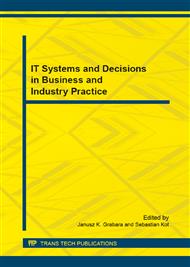[1]
R. Obal, Maximizing buyer-supplier relationships in the Digital Era: Concept and research agenda, Industrial Marketing Managment, vol. 42, no. 6, 2013, pp.851-854.
DOI: 10.1016/j.indmarman.2013.06.002
Google Scholar
[2]
C. C. Luminita Chivu, About Industrial Structures Decomposition and Recomposition, Procedia Economics and Finance, pp.157-166, (2014).
DOI: 10.1016/s2212-5671(14)00076-8
Google Scholar
[3]
M. Mary Uhl-Bien, Complexity Leadership Theory: Shifting leadership from the industrial age to the knowledge era, The Leadership Quarterly, vol. 18, no. 4, 2007, pp.298-318.
DOI: 10.1016/j.leaqua.2007.04.002
Google Scholar
[4]
S. Sununta, Economies, Making Industrial Relations Work in the Globalization Era: Challenges Ahead for Knowledge-Based, The Multi-Dimensions of Industrial Relations in the Asian Knowledge-Based Economies, 2010, pp.215-226.
DOI: 10.1016/b978-1-84334-264-9.50009-x
Google Scholar
[5]
M.N. Bassim, Economic Implications of Impact of Manufacturing on Environment and Health, Comprehensive Materials Processing, 2014, pp.199-210.
DOI: 10.1016/b978-0-08-096532-1.00817-7
Google Scholar
[6]
S. Muhammed, Antecedents and Impacts of Knowledge Management Practices Supported by Information Technology: An Empirical Study in Manufacturing Context, The University of Toledo, Toledo, (2006).
Google Scholar
[7]
G.P. Huber, Issues in the Design of Group Decision Suppoert Systems, MIS Quarterly, 1984, pp.195-204.
Google Scholar
[8]
Ion Ivan, Metrics of Collaborative Business Systems in the Knowledge- based Economy, Procedia Computer Science, vol. 31, 2014, pp.379-388.
DOI: 10.1016/j.procs.2014.05.281
Google Scholar
[9]
M. B. S. Habib Mortazavi, Integrated Approach to Entrepreneurship – Knowledge based Economy: A Conceptual Model, Procedia - Social and Behavioral Sciences, vol. 41, 2012, pp.281-287.
DOI: 10.1016/j.sbspro.2012.04.032
Google Scholar
[10]
M. Mary Uhl-Bien, Complexity Leadership Theory: Shifting leadership from the industrial age to the knowledge era, The Leadership Quarterly, vol. 18, no. 4, 2007, pp.298-318.
DOI: 10.1016/j.leaqua.2007.04.002
Google Scholar
[11]
M. S. Mioara, The Impact of Technological and Communication Innovation in the Knowledge-Based Society, Procedia - Social and Behavioral Sciences, vol. 51, 2012, pp.263-267.
DOI: 10.1016/j.sbspro.2012.08.156
Google Scholar
[12]
A. Kanagasabapathy, Empirical Investigation of Critical Success Factor and Knowledge Management Structure for Successful Implementation of Knowledge Management System: A Case Study in Process Industry, 2006. [Online].
Google Scholar
[13]
L. P. a. J. G. Ouintas P., Knowledge management: a strategic agenda, Long Range Planning, vol. 30, no. 3, 1997, pp.385-391.
Google Scholar
[14]
V. Allee, Twelve principles of knowledge management, Training & Development, vol. 51, no. 11, 1997, pp.71-74.
Google Scholar
[15]
L. D. Alavi M., "Review: knowledge management and knowledge management systems: conceptual foundations and research issues, MIS Quarterly, vol. 25, no. 1, 2001, pp.107-136.
DOI: 10.2307/3250961
Google Scholar
[16]
B. M. Davenport T., Successful knowledge management projects, Sloan Management Review, vol. 39, no. 2, 1998, pp.43-57.
Google Scholar
[17]
A. J. Gupta B., Knowledge management: practices and challenges, Industrial Management & Data Systems, vol. 100, no. 1, 2000, pp.17-21.
Google Scholar
[18]
G. Bhatt, "Knowledge management in organizations: examining the interaction between technologies, techniques, and people, Journal of Knowledge Management, vol. 5, no. 1, 2001, pp.68-75.
DOI: 10.1108/13673270110384419
Google Scholar
[19]
Holm J., Capturing the spirit of knowledge management, in American Conference on Information Systems, Boston MA, (2001).
Google Scholar
[20]
A. R. Horwitch M., Helping knowledge management be all it can be, Journal of Business Strategy, vol. 23, no. 3, 2002, pp.26-32.
Google Scholar
[21]
B. Bergeron, Essentials of Knowledge Management, Hoboken NJ: John Wiley & Sons, Inc., (2003).
Google Scholar
[22]
I. Watson, Applying Knowledge Management, San Francisco: Morgan Kaufmann Publishers, (2003).
Google Scholar
[23]
F. A. Uriarte, Introduction to Knowledge Management, Jakarta: ASEAN Foundation, (2008).
Google Scholar
[24]
S. A. Haslinda A., A Review of Knowledge Management Models, The Journal of International Social Research, 2009, pp.187-198.
Google Scholar
[25]
M. &. McCreedy, A critical review of Knowledge Management Models, The Learning Organization, 1999, pp.91-101.
Google Scholar
[26]
N. I. Hedlund G., Models of Knowledge Management in the West and Japan., Implementing Strategic Process, Change, Learning and Cooperation, 1993, pp.117-144.
Google Scholar
[27]
Frid R., A common KM Framework For The Government of Canada: Frid Framework For Enterprise Knowledge Management, Canadian Institute of Knowledge Management, Ontario, (2003).
Google Scholar
[28]
D. Caganova, I. Szilva and Woolliscroft P, Knowledge Management in the Assembly Process of Small Hydro Power Plants, in Restructuring of the Global Economy (ROGE), Cambridge, (2014).
Google Scholar


